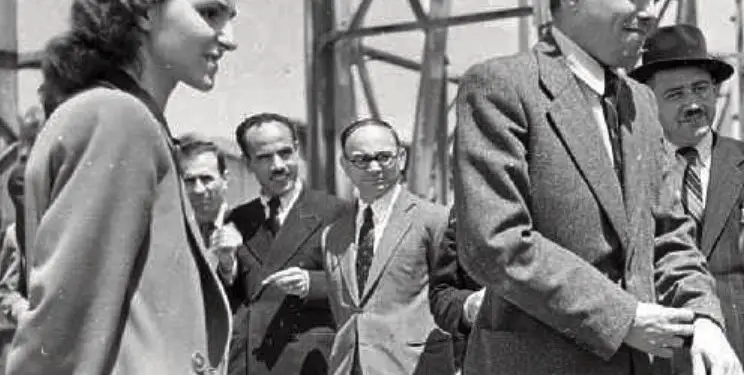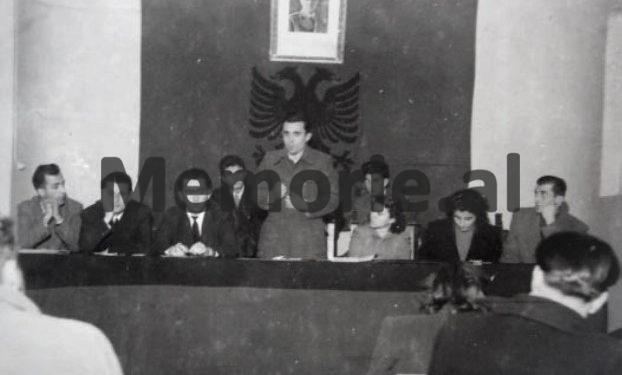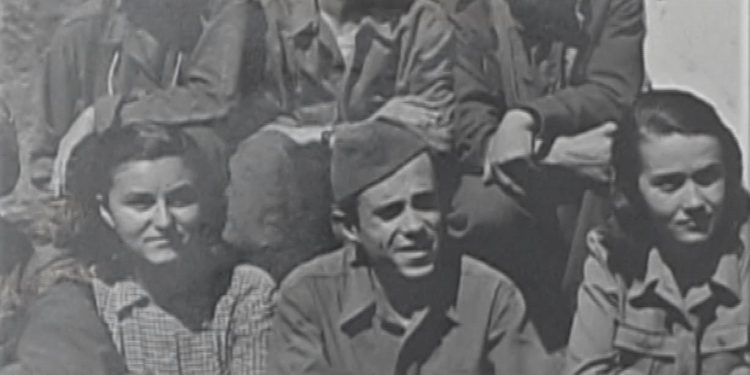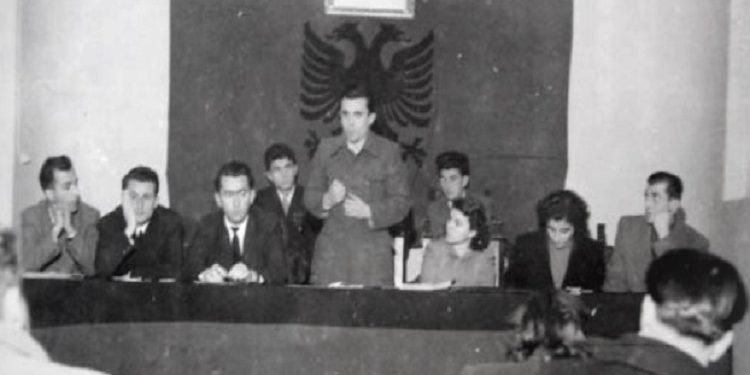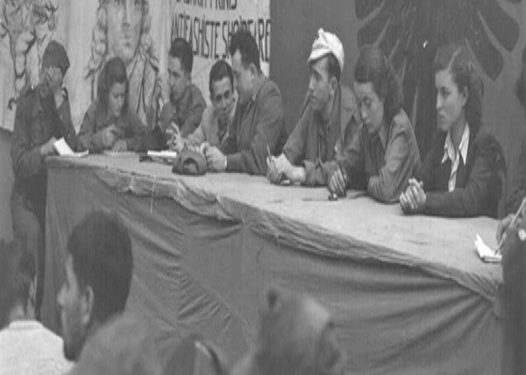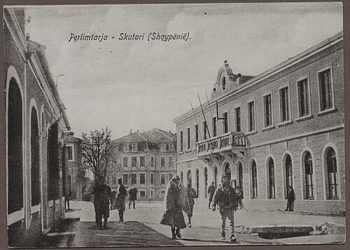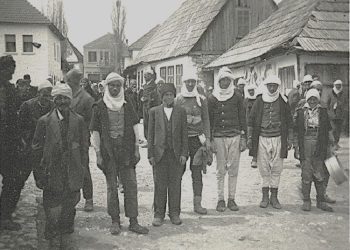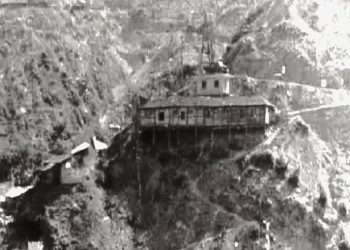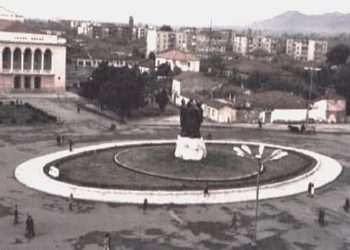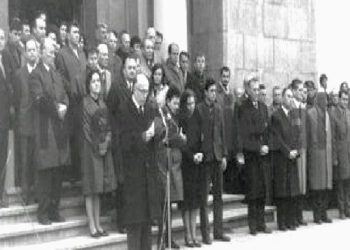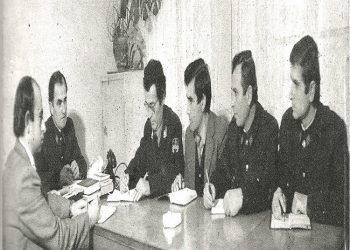By Kastriot Dervishi
-Nako Spiru, the witness who saw the scene of the ex-minister’s murder is revealed-
Memorie.al / “Political bullets”! In the book by Kastriot Dervish, the former Director of the Archive of the Ministry of the Interior, a series of murders of political people is reflected. The murder of Nako Spiros, which we chose to publish in full in today’s issue, is among the first mysterious murders of the communist dictatorship, which was labeled as “suicide”. Crucified by Enver Hoxha as an anti-Slav, for daring to declare that; “Albania could build its economy even without the help of Tito’s Yugoslavia”, Nako Spiru chose the path of self-poisoning, leaving open the accusation for the short-sighted policy of the Albanian Communist Party, which had become a satellite of Belgrade. How Nanko Spiru commit suicide and what did was the reaction of the political leadership to his act, how communist propaganda treated the contribution during the National Liberation War, and what attitude did he take to the fatal act of suicide, etc.
This is one of the first murders of the communist era that ended with the words “suicide”. Mehmet Shehu, who was waiting in the lobby of the hospital, the fate of his friend who gave his soul, Nako Spiru, would have the same fate himself, since the murder among the communist leaders of Tirana over the years, would be covered with the softened concept , unproblematic of suicide.
This is because in the long span between 1947 and 1981, almost nothing would change; only the tricks would be thinned out. On the morning of November 22, 1947, the only daily newspaper in the country, “Bashkimi”, announced the “accidental” death of Minister Nako Spiru, caused by “playing with a weapon”.
Until that moment, the conflict raging within the top communist leadership was not recognized and one minister was already reported dead.
Nako Spiru, in fact, had understood the economic ruin that Albania was suffering from the Yugoslavs and had opposed the continuation of the slavery agreements with them, although, ironically, he was the person who had signed the agreements in question on behalf of the government of Albania.
The moment of the unification of the currencies between Albania and Yugoslavia had come, while the Albanian market was becoming more and more impoverished by the looting by the Yugoslavs. At the meeting of the Political Bureau on May 29, 1947, it was said that the single currency would enter into force in June 1947, while Nako Spiru asked some questions, discussing the signed agreement, showing opposition to the implementation of the agreement that unified the currencies respective of the two countries.
Targeting the Yugoslavs
Here the Yugoslavs understood that the first Albanian voice that was opposing had to be stopped. In June 1947, the Yugoslav Communist Party, through Savo Zllatić, accused that a second anti-Yugoslav line had crystallized in the Communist Party of Albania. There was no other person in the leadership who represented this “line”, except for Nako Spirut, and his supporters who did not hold high positions.
The conflict continued like this in other months as well. Following this war, which did not plan only submission, on November 8, 1947, the leadership of the Communist Party of Yugoslavia directed another accusation to the leadership of the Albanian Communist Party, criticizing certain elements, as well as some sectors that do not went well in bilateral relations.
The Yugoslav communist leadership began to raise with concern the fact that two political lines had been created within the NPSH, one of which was anti-Yugoslav. At the center of the attacks was Nako Spiru, Fadil Paçrami, etc. (AQSH, “Albanian – Yugoslav relations 1945 – 1948”, Tirana 1996, page 124).
Ten days later, spurred by this accusation, the issue of Nako Spiru’s anti-Yugoslavism was brought up in the Political Bureau of the Central Committee of the NPSH, while this issue had been closely discussed between Savo Zllatić, Enver Hoxha and Koçi Xoxa in a long period of time, on November 6-18, 1947. At the meeting of the Political Bureau, Koçi Xoxe says that; the basis of the relationship between the two countries was broken, in matters related to the economy and the military. In this meeting, Nako Spiru, but also Mehmet Shehu, was accused of being anti-Yugoslav.
Circumstances of death
Being attacked from all sides, Spiru asked Enver Hoxha for 5 days to respond. But he was not given more than 24 hours. During the day, he tried to seek support from the Soviets, but they did not miss him. As the 24-hour deadline expired, on November 20, 1947, Nako Spiru was hit by a bullet in the heart. Try not to die at once. The Deputy Minister of Internal Affairs and Director of State Security, Colonel Nesti Kerenxhi, was present at the scene.
Measures were taken to prevent anyone from entering the hospital, not even the wife (Liri Belishova), until the murder was possible. The witness Dh.Sh., (once a typist of the Ministry of Foreign Affairs and at that moment working in the State Planning Commission), had seen the whole scene, but he could not fix the person responsible for the murder, because of the confusion that has caught him. And this, not without reason. The murder had been assigned to him against his will. He had simply performed his duty to the party.
The lifeless body of Nako Spiru was placed in the hall of the People’s Assembly for homage. Everything seemed to be done with difficulty, just for the sake of it. They did not end their anger with Nako Spiru here, as a few months later, in February-March 1948, they would not leave anything unsaid against him. At the funeral ceremony, the vice-president of the State Plan Commission, Kiço Ngjela, speaking there, said that “an unfortunate accident” had taken their friend’s life. Spiro Koleka spoke on behalf of the government and Ramiz Alia on behalf of the youth (“Bashkimi”, November 23, 1948).
Announcements from Moscow and reports from Belgrade
The Ambassador of Albania in Moscow, Mihal Prifti, a few days after the murder, on November 30, 1947, sends a letter to Tirana (Nesti Kerenxhi and Enver Hoxha), regarding the echo of the murder of Nako Spiru, where he writes: “For your information, yes I am writing to you briefly about the conversation I had with Comrade Petrov, about the murder of Comrade Nako, on the evening of November 28, 1947.
I opened the conversation, asking him if he knew about his murder. He tells me that before, he wanted to know from me what had happened and under what circumstances. I answered that; I don’t know details about it. Without me telling him anything else, he began to think and after a while he tells me: ‘And I don’t understand how his murder could be possible.
We have received three telegrams from Tirana, but we are still not clear about his murder. Telegrams contradict each other. One says he was hit in the arm, the other says he was hit in the leg, the other elsewhere. I don’t understand how it happened that the telegrams are not regular’. I had nothing to say…!
He rests a bit, shakes his head and continues concluding: So, it is not clear to us, his murder, but however he tells me confidentially, that; for 3-4 days, he will go to Tirana himself, in connection with the preparation of the congress, and everything will be clarified well’. And he continues: “However likely it is, Nako’s murder is not important to us.” It is enough for Enveri and Koçi to implement the straight line of the party”… (A.M.B., Fondi Dega e Shifra, Year 1947, File 9, sheets 1 – 3).
Interesting reports, even from the Belgrade archives!
The information from these archives shows that Belgrade has imposed everything, not only for the action but also for the funeral ceremony, while Enver Hoxha has been in touch with them about how he should act. On November 21, 1947, one of the organizers of the murder, Savo Zllatiči, informed the Minister of Internal Affairs of Yugoslavia, Aleksandër Ranković, that; “Nako Spiru, killed himself playing with a revolver”.
For this, he was looking for the opinion that he should convey to his “Albanian friends”, whether the murder should be treated as suicide or an unfortunate case. That same day, Savo Zllatiçi announced to “comrade Marko” (Aleksandër Ranković’s war nickname), that Nako Spiru, has written a letter to the Soviet charge d’affaires, to which he left it on the table.
There he mainly presents some things from the meeting of the Central Committee, where he defends his position and recalls that he consulted with Soviet specialists on a number of issues. He gave the letter from the Central Committee of the KPSH to the Soviet charge d’affaires, begging him for a copy. Focusing on the other issue, Zllatić telegraphed the center as follows: “Enveri presented the issue to me, so that I could see everything clearly, what a great anti-party activity Nako had developed.
Regardless of the current event, the policy implemented by Nako must be unmasked in the party. At the same time, among other things, Enveri asked me if the funeral procession would take place tomorrow. Zlatić addresses Marko, saying that; Albanians ask whether or not Enver Hoxha should be present at the funeral ceremony the next day, questioning the legitimacy of Hoxha in Albania…! (State Archive of Yugoslavia, SKSKJ Fund, 1X. 8.V.288).
The VIII Plenum confirmed the murder
The events of 1948 culminated in the 8th Plenum of the Central Committee of the KPSH, held from February 26 to March 27, 1948. On its agenda were the proposals of the Political Bureau, analyzing the internal situation regarding the relations with Yugoslavia, on the mistakes in the economic line of the party…! The “hostile work” of Nako Spiru was condemned, who, according to the discussants, had worked to destroy “fraternal” relations with Yugoslavia, had quarreled with “Yugoslav comrades”, on economic issues, the works of the army, had worked against Yugoslav advisers, etc. .
According to the report, Nako Spiru had said, after signing the economic agreement, that with this action he had signed the sale of Albania. Spiru was accused as a saboteur of the “rapid organization and on the right path, on the fraternal path”, of both peoples and common societies, that he had sabotaged the implementation of the customs union, had encouraged anti-Yugoslav thinking in the Bureau Political, raising (according to Savo Zllatić), two opposite lines.
In the second point, it was said that Spiru had distorted the economic policy (which included agriculture), which the NPSH had defined as developable, “only with the support of the economy of the RPFJ”…! In the army, Mehmet Shehu, who had quarreled several times with the Yugoslav Chief of Staff, Koca Popovic, was considered to be a “factionalist collaborator” of Nako Spiru, regarding the union of the two armies.
Also in this meeting, Fadil Paçrami and Liri Belishova’s work with youth was also condemned. In the following meeting of February 26, 1948, Enver Hoxha proposed that the members of the plenum of the Central Committee, Liri Belishova and Mehmet Shehu, not participate in the plenum. Hoxha, in his speech, defended the view that; “the alliance with Yugoslavia was one of the biggest victories”, because Nako Spiru had been against this connection, causing “very big consequences” for the NPSH.
According to Hoxha, Spiru had requested that the Albanian economy progress and the Yugoslavs help, calling this; “isolation of the Albanian economy”. Nako Spiru had declared that Albania could do economically “even without the help of Yugoslavia”. Enver Hoxha, again accused as collaborators of Spiru: Liri Belishova (Nako’s wife), Mehmet Shehu and Fadil Paçram, whom he described as; “dangerous people”.
For Hoxha, the question of the line with Yugoslavia was “vital”, because Stalin, Molotov and Tito had instructed in this way. From the words of Adil Çarçani, it appears that Nakos was put under tremendous pressure to sign economic agreements with Yugoslavia and that his work (Nakos) had been “very harmful to the country”.
Manush Muftiu, claimed that; Spiru’s war against Yugoslavia was intended to weaken the positions of the Communists of Albania, adding that; Spiru was a “chauvinist”. Koçi Xoxe says that; Nako Spiru had intended to build another line of the NPSH, which would be against Yugoslavia. Bedri Spahiu says about Spiru, that he came out as he was: “son of a bourgeois”. Hysni Kapo says that he had talked with Nako when he was ambassador in Belgrade and, according to him; he has shown great resentment towards the Yugoslavs.
Gogo Nushi says that the object of Nako’s work was the destruction of relations with Yugoslavia. Tuk Jakova called him “the protagonist of the entire destruction of the party line”, as he had worked to “hit the ties with Yugoslavia”. Beqir Balluku, after praising the KPJ, for its role in the formation of the KPSH, affirmed that; Nako was against Yugoslavia, because he was an “agent”, since he came from the bourgeois class and had no connection with other communists. Balluku stated that; Nako came out in favor of the “independence of our country”, as he was a “bourgeois chauvinist”.
Very active was the discussant, Petro Papi, who has been tough on Nako’s work. In the next meeting on March 3, Haki Toska states that; he was convinced of the betrayal of Nako Spiru, that it had aggravated the relations with Yugoslavia and that “it took the intervention of the PKJ to resolve the issue”. Nesti Kerenxhi appreciated the help of PKJ in solving the case. Koçi Xoxe claimed that Nako understood the relations with the Yugoslavs, like his father with STAMLES. Xoxe said that; only Yugoslavia could help Albania and that “all issues will go towards unification”…!
Continuing on this line, at the meeting of the Political Bureau, on March 14, 1948, the issue of the union between Albania and Yugoslavia was discussed, which is also accepted by Enver Hoxha even in the conditions born in the south of Albania. The day after, he says that; the Yugoslavs could mobilize 9 thousand people, while on March 17, 1948, he sent a letter to Tito, regarding the federal union between the two countries, in which he stated that; the Albanian people were “so connected spiritually and economically with the peoples of Yugoslavia, than any other people”, that; “this union had nothing formal”, but it was deeply felt, insisting that work had to be done; “specifically for the federation”, which, in Albania, was being worked on “with all the forces”.
The 8th Plenum had closed its proceedings on March 8, but on March 27, 1948, it reconvened to adopt the resolution. Liri Belishova, Sejfulla Malëshova, Fadil Paçrami and Ymer Dishnica were expelled from the party. Mehmet Shehu, was expelled from the Central Committee. Other persons mentioned were Niko Opari, Muhamer Spahiu and Qamil Buxheli. (“AQSH, Albanian-Yugoslav Relations 1945-1948”, Tirana 1996, page 214-432).
The testimonies of the people who watched it
For almost a year, Nesti Kerenxhi, the man who had escaped imprisonment in the most surprising way, after a letter he sent to Enver Hoxha, from the place where he lived (Selenica), was accused as a member of the “Koçi Xoxes group” . He remained in the investigation of Vlora and Tirana until he testified against Kadri Hazbiu. In this last exchange, he won his freedom for the last time. Asked about many events from the war until recently, among other things, he testifies about the murder of Nako Spiru, apparently being a key person in the organization of this murder.
On November 19, 1947, Nesti Kerenxhi, on this cold day before winter, was staying in his house. Suddenly the house phone rings. On the other hand, the Minister of Internal Affairs, Koçi Xoxe, was calling. He asks him to pay him a visit at home. This is what Kerenxhi did. He went to his boss’s house, where he also found Pandi Kristo.
Koçi ordered them, together with Pandi Kristo, to go to Kristo Themelko’s house and guard the actions of Nako Spiru, who had a house nearby. Deputy Minister Kerenxhi and Minister Pandi Kristo have acted as traveling agents, guarding Minister Nako Spiru. The concern of Kochi was; whether or not anyone would meet him at night Nako Spiru. In fact, there had been no movement that night.
The next day, Nako went to work. Kerenxhi went after him in a car, with a driver, Lefter Lakrorin. Nako had gone to the Beshir Bridge and returned. Maybe he realized that he was being followed. The car with driver Lefter had continued on the road to avoid being understood, while Kerenxhi had lowered his head so as not to be recognized by Nako Spiru, when the two cars were exchanged.
Then Nako entered his office of the State Plan Commission. After hearing the shots that hit the tracked man, Kerenxhi and Lakrori entered Nako’s office and took him to the hospital, where according to the order, Kerenxhi checked his pockets. Nako’s contradiction with Koçi also emerged from Kerenxhi’s questionnaire.
But the observation continued even at the funeral ceremony. Myftar Tare, questioned as a witness, claimed on January 17, 1983, that when Nako Spiru was being buried, Lefter Lakrori had ordered him to stay close to the family, to hear what they had to say. His reporting had been simple. During the ceremony, Nako’s father had fainted. He had seen that Liri Belishova was holding Nako’s sister by the hair and telling her to keep herself.
According to him, Nako had realized that he was being followed by the car driven by Lefter Lakrori, at that time Nest’s driver. Also, they say that a special agency network was set up to monitor Nako and his work in the ministry, directed by Ferdi Tirana and Hilmi Seiti. Even Lefter Lakrori accuses Nesti, on February 12, 1983. (AMB, F.H-GJ, D.12653). Everyone had remembered that; Nest is over. They were wrong for the last time. In the official reports, there are dozens of pieces of information that mention who killed Nako Spiru.
However, the main people who survived this death, with all the vicissitudes they went through, did not have the courage even at the end of their lives, to affirm that; Nako Spiru was killed. They remained loyal to the “suicide” option, without showing even the remotest moral remorse. In the Archives of the Ministry of the Interior, the autopsy of the body of Nako Spiru, which formally should have been done, was not filed.
In the first half of 1949, the process of Koçi Xoxes and others took place. Both during the investigation and during the trial, Xoxe, repeat several times that; the tracking of Nako Spiru was done only by the order of Enver Hoxha and he only implemented it. (AMB, F.H-Gj, D.1623). Memorie.al




